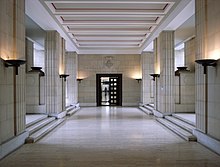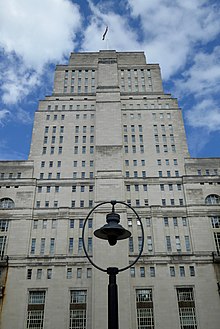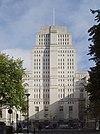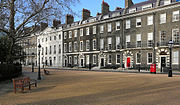Senate House, London
51°31′16″N 0°07′43″W / 51.5210°N 0.1287°W
| Senate House | |
|---|---|
 The Senate House of the University of London | |
 | |
| General information | |
| Architectural style | Art Deco, Neo-Classical |
| Town or city | London, WC1 United Kingdom |
| Construction started | 1932 |
| Completed | 1937 |
| Client | University of London |
| Design and construction | |
| Architect(s) | Charles Holden |
Listed Building – Grade II* | |
| Official name | Senate House, London |
| Designated | 28 March 1969 |
| Reference no. | 1113107 |
Senate House is the administrative centre of the University of London, situated in the heart of Bloomsbury, London, immediately to the north of the British Museum.
The Art Deco building was constructed between 1932 and 1937 as the first phase of a large uncompleted scheme designed for the university by Charles Holden. It consists of 19 floors and is 210 feet (64 m) high.[1]
During the Second World War, the building's use by the Ministry of Information inspired two works of fiction by English writers. The earliest, Graham Greene's novel The Ministry of Fear (1943), inspired a 1944 film adaptation directed by Fritz Lang set in Bloomsbury.[2] The description of the Ministry of Truth in George Orwell's novel Nineteen Eighty-Four (1949) evokes the Senate House. His wife Eileen worked in the building for the Censorship Department of the Ministry of Information.[3]
Today the main building houses the University of London's Central Academic Bodies and activities, including the offices of the vice-chancellor of the university, the entire collection of the Senate House Library, six of the eight research institutes of the School of Advanced Study, as well as departments of distance learning provider University of London Worldwide.
History
[edit]After the First World War the University of London, then based at the Imperial Institute in Kensington was in urgent need of new office and teaching space to allow for its growth and expansion. In 1921, the government bought 11 acres (4.5 ha) of land in Bloomsbury from the Duke of Bedford to provide a new site for the university. However, many within the university were opposed to a move, and, in 1926, the Duke bought back the land. However, the election of William Beveridge to the post of vice-chancellor of the university in June 1926 was highly significant as Beveridge supported a move to Bloomsbury. Beveridge persuaded the Rockefeller Foundation to donate £400,000 to the university and the original site was reacquired in 1927.[4]

Beveridge saw the university as one "for the nation and the world, drawing from overseas as many students as Oxford and Cambridge and all the other English universities together."[5] and specified that "the central symbol of the University on the Bloomsbury site can not fittingly look like an imitation of any other university, it must not be a replica from the Middle Ages. It should be something that could not have been built by any earlier generation than this, and can only be at home in London ... (the building) means a chance to enrich London – to give London at its heart not just more streets and shops ... but a great architectural feature ... an academic island in swirling tides of traffic, a world of learning in a world of affairs."[5]
The grand art deco design was the work of Charles Holden, who was appointed as architect in March 1931 from a short list which also included Giles Gilbert Scott, Percy Scott Worthington, and Arnold Dunbar Smith.[1] In making their choice, Beveridge and the Principal, Edwin Deller, were influenced by the success of Holden's recently completed 55 Broadway, designed as the headquarters for the London Electric Railway and then the tallest office building in London.[1]
Holden's original plan for the university building was for a single structure covering the whole site, stretching almost 1,200 feet (370 m) from Montague Place to Torrington Street. It comprised a central spine linked by a series of wings to the perimeter façade and enclosing a series of courtyards. The scheme was to be topped by two towers; the taller Senate House and a smaller one to the north.[1] The design featured elevations of load-bearing brick work faced with Portland stone.[1][6] Construction began in 1932 and was undertaken by Holland, Hannen & Cubitts.[7] King George V laid the ceremonial foundation stone on 26 June 1933 and the first staff moved in during 1936, the university's centenary year. On 27 November 1936, a group of university officials, led by the Principal, Sir Edwin Deller, went out to inspect the work in progress. Suddenly, without warning, a skip being pushed by a workman overhead accidentally fell down and hit them. All were rushed to University College Hospital, where three days later, Deller died of his injuries.[8] Due to a lack of funds, the full design was gradually cut back, and only the Senate House and Library were completed in 1937,[1] although the external flanking wings of the north-eastern courtyard were not constructed.[9] As he had with his earlier buildings, Holden also prepared the designs for the individual elements of the interior design.[1][9] The completion of the buildings for the Institute of Education and the School of Oriental Studies followed, but the onset of the Second World War prevented any further progress on the full scheme.
Critical opinion
[edit]
The architectural character and scale of the building has received both positive and negative criticism since its construction. Steen Eiler Rasmussen, a friend of Holden, commented that, with the expansive design, "the London University is swallowing more and more of the old houses, and this quarter – which the Duke of Bedford laid out for good domestic houses – has taken on quite a different character."[10] Evelyn Waugh, in Put Out More Flags (1942), describes it as "the vast bulk of London University insulting the autumnal sky."[11]
Positive comments came from functionalist architect Erich Mendelsohn in 1938, who wrote to Holden that he was "very much taken and am convinced that there is no finer building in London."[12] Architectural historian Arnold Whittick described the building as a "static massive pyramid ... obviously designed to last for a thousand years", but thought "the interior is more pleasing than the exterior. There is essentially the atmosphere of dignity, serenity and repose that one associates with the architecture of ancient Greece."[13] Nikolaus Pevsner was less enthusiastic. He described its style as "strangely semi-traditional, undecided modernism" and summarised the result: "The design certainly does not possess the vigour and directness of Charles Holden's smaller Underground stations."[14] Others have described it as Stalinist[15] or as totalitarian due to its great scale.[1]
Holden recognised that his architectural style placed him in "rather a curious position, not quite in the fashion and not quite out of it; not enough of a traditionalist to please the traditionalists and not enough of a modernist to please the modernists."[16]
Present day
[edit]

Senate House remains a prominent landmark throughout Bloomsbury and is visible from some distance away. The building was listed as Grade II* in 1969.[17] Following a multimillion-pound refurbishment in 2006, Senate House has also become a conference and event venue playing host to some of the city's most prestigious events including London Fashion Week.
Following the relaxation of the rules in the UK on university status under the Major government and consequential stirrings towards full independence of the larger London University colleges, the future of Senate House and its library has from time to time been called into question. However, Senate House remains, and continues to be home both to the vice-chancellor of the University of London and to the deep resources of the university library; indeed, it re-opened in 2006 after undergoing a refurbishment to bring it up to modern standards and to reinstate some of Holden's original interiors.
Some schools in constituent colleges, such as the Birkbeck School of Computer Science and Information Systems (until 2010), and the School of Advanced Study (the UK's national centre for the facilitation and promotion of research in the humanities and social sciences) are or were based in Senate House. SOAS moved into the north block of Senate House from 2016.[18]
The main entrance is from Malet Street to the west and the rear entrance from Russell Square to the east.
In recent years, Senate House has been associated with high-profile industrial relations disputes. In December 2018, a boycott of the University of London, including Senate House, organised by the Independent Workers' Union of Great Britain and supported by a number of high-profile politicians, journalists and academics, including John McDonnell, Owen Jones, Ken Loach and David Graeber came into effect. This campaign of 'direct action' aims to put pressure on the University of London to bring outsourced workers back into the employment of the university by targeting what is a major source of both prestige and revenue for the university.[19][20][21] Numerous events during the 2018–19 academic year were cancelled or relocated, and over 350 individual academics, as well as a number of UCU branches all signatories to the campaign.[22] In May 2019 receptionists, porters as well post room and audio-visual (AV) equipment workers were made University of London staff, followed by security guards in May 2020.[23][24]
Senate House Library
[edit]
Senate House Library (formerly known as the University of London Library) occupies the fourth to the 18th floors of the building, with the public areas of the library on the fourth to seventh floors.[25] The library is open to staff and students of all colleges within the university (although levels of access differ between institutions) and contains material relevant chiefly to arts, humanities, and social science subjects.[26]
The library is administered by the central university as part the Senate House Libraries, and in 2005 had more than 32,000 registered users. It holds around three million volumes, including 120,000 volumes printed before 1851.[27] The library started with the foundation of the University of London in 1836, but began to develop from 1871 when a book fund was started.[27]
Along with a subscription to over 5,200 journals, other resources include the Goldsmiths' Library of Economic Literature,[28] and the Palaeography room's collection of western European manuscripts.[29] The library also holds over 170,000 theses by graduate students.[27] From 2006 onwards, the library has been undergoing a comprehensive refurbishment process.[30][31]
The library is also home to the University of London archives,[32] which include the central archive of the university itself and many other collections, including the papers of social reformer Charles Booth,[33] philosopher Herbert Spencer,[34] actress and mystic Florence Farr,[35] author and artist Thomas Sturge Moore,[36] writer Opal Whiteley,[37] and publishing company Gerald Duckworth and Company Ltd.[38]
Since June 2021, the librarian has been Catríona Cannon; she is also director of the Library Transformation Programme for the University of London.[39]
In popular culture
[edit]
Due to its imposing architecture, Senate House is popular with the film and television industries as a shooting location; often for official buildings. It inspired the description of the Ministry of Truth in George Orwell's Nineteen Eighty-Four.[3]
Films that have featured the building include the 1995 version of Richard III (interior of a government building), the 1984 film of Nineteen Eighty-Four (exterior of the apartment building where O'Brien lives), Blue Ice (a hotel), Spy Game (lobby of CIA Headquarters), Batman Begins (lobby of a court), The Dark Knight Rises (a costume ball), Nanny McPhee and the Big Bang (a war office), Fast & Furious 6 (Moscow Interpol HQ), Jack Ryan: Shadow Recruit (Moscow restaurant), No Time to Die (MI6 Reception) and The 355 (a Shanghai casino).[40][41][42][43][44][45]
For television, the building has featured in Jeeves and Wooster (the exterior of Wooster's Manhattan apartment building), Killing Eve,[46] and other programmes. Senate House is a prominent location in the first chapters of the 1951 post-apocalyptic novel The Day of the Triffids by John Wyndham, and was thus used (as itself) in the television adaptation The Day of the Triffids.
See also
[edit]References
[edit]Notes
[edit]- ^ a b c d e f g h Karol, Eitan (Autumn–Winter 2008). "Naked and unashamed: Charles Holden in Bloomsbury" (PDF). Past and Future (4). London: The Institute of Historical Research: 6–7. Retrieved 27 May 2009.[permanent dead link]
- ^ Pleßke, Nora (2014). The Intelligible Metropolis: Urban Mentality in Contemporary London Novels. Transcript Verlag. p. 285. ISBN 9783839426722. Retrieved 9 June 2015.
- ^ a b Hill, Dan (22 November 2003). "Senate House, University of London". City of Sound. Retrieved 27 May 2009.
- ^ "Senate House Library, University of London". Beginnings: The History of Higher Education in Bloomsbury and Westminster. Institute of Education, University of London. Archived from the original on 23 December 2012. Retrieved 9 July 2009.
- ^ a b Beveridge, quoted by Hill, Dan (22 November 2003). "Senate House, University of London". City of Sound. Retrieved 27 May 2009.
- ^ Holden used Portland stone frequently as he considered it "the only stone that washes itself" (Karol), capable of withstanding London's then smoggy atmosphere.
- ^ Cubitts 1810 – 1975, published 1975
- ^ s, T. F. (December 1936). "Sir Edwin Deller – Abstract Nature". Nature. 138 (3503): 1043–1044. doi:10.1038/1381043a0. S2CID 4130510.
- ^ a b Rice, Ian (September 2003). "Building of the Month". The Twentieth Century Society. Archived from the original on 20 January 2009. Retrieved 27 May 2009.
- ^ Rasmussen, Steen Eiler (1934). London: the Unique City. MIT Press. ISBN 0-262-18017-0. – quoted in Karol.
- ^ Waugh, Evelyn (1942). Put Out More Flags. Heinemann/Octopus. ISBN 0-905712-15-3. – quoted in Karol.
- ^ Mendelsohn, quoted in Karol.
- ^ Whittick 1974, p. 515.
- ^ Cherry & Pevsner 1998, p. 276.
- ^ Jenkins, Simon (2 December 2005). "It's time to knock down Hitler's headquarters and start again". The Guardian. Retrieved 27 May 2009.
- ^ Holden, quoted in Karol.
- ^ "Images of England – Record 477485". National Monument Record. English Heritage. 2007. Retrieved 28 May 2009.
- ^ "SOAS into Senate House". Archived from the original on 12 August 2014. Retrieved 5 August 2014.
- ^ "Largest university in UK hit by boycott over outsourced staff". Personnel Today. 10 December 2018. Retrieved 21 February 2019.
- ^ "Academics, politicians and trade unionists join boycott of UofL's use of outsourced workers". Morning Star. Retrieved 21 February 2019.
- ^ "Boycott Over Outsourcing Could Cost University £Millions". Twin FM. Retrieved 21 February 2019.
- ^ "Boycott Senate House". IWGB. Retrieved 21 February 2019.
- ^ "FM Review Update August 2020". University of London. Archived from the original on 24 February 2021. Retrieved 17 September 2020.
- ^ "FM Review update – June". University of London. Archived from the original on 15 December 2021. Retrieved 17 September 2020.
- ^ "Senate House Library: Floorplans". University of London Research Library Services. Retrieved 10 July 2009.
- ^ "Collections & Gateways". Senate House Library. Archived from the original on 23 December 2008. Retrieved 9 July 2009.
- ^ a b c "Senate House Library: facts & figures". University of London Research Library Services (via Internet Archive). 2005. Archived from the original on 21 November 2007. Retrieved 27 May 2009.
- ^ "Goldsmiths' Library of Economic Literature". Senate House Library. Archived from the original on 29 March 2010. Retrieved 9 July 2009.
- ^ "The Palaeography Room". Senate House Library. Archived from the original on 17 July 2011. Retrieved 9 July 2009.
- ^ Summary Library Moves: Music Collection Archived 31 March 2012 at the Wayback Machine
- ^ Re-Opening Floors 4 – 6 & Closing Temporary Areas 30 August – 2 September Archived 31 March 2012 at the Wayback Machine, 25 August 2011
- ^ "Deposited Collections and Manuscripts". University of London Research Library Services. Archived from the original on 17 July 2011. Retrieved 27 May 2009.
- ^ "Catalogue of Archives and Manuscripts – Booth, Charles (1840–1916) and Mary Catherine (1847–1939)". University of London Research Library Services. Retrieved 15 June 2009.
- ^ "Catalogue of Archives and Manuscripts – Herbert Spencer Papers". University of London Research Library Services. Retrieved 15 June 2009.
- ^ "Catalogue of Archives and Manuscripts – Florence Farr Papers". University of London Research Library Services. Retrieved 15 June 2009.
- ^ "Catalogue of Archives and Manuscripts – Thomas Sturge Moore Papers". University of London Research Library Services. Retrieved 15 June 2009.
- ^ "Catalogue of Archives and Manuscripts – Opal Whiteley Papers". University of London Research Library Services. Retrieved 15 June 2009.
- ^ "Catalogue of Archives and Manuscripts – Gerald Duckworth and Co Ltd". University of London Research Library Services. Retrieved 15 June 2009.
- ^ "New Librarian for University of London's Senate House Library". University of London. Archived from the original on 2 March 2023. Retrieved 2 March 2023.
- ^ "Filming Locations near to: Senate House, University of London, Malet St, Bloomsbury, London WC1E 7HU, UK". British Film Locations. Retrieved 17 March 2018.
- ^ "Open House London". Film London. 12 September 2007. Archived from the original on 20 August 2018. Retrieved 29 May 2011.
- ^ Iain Stasukevich (1 August 2012). "Batman to the Max". American Cinematographer. 93 (8). Los Angeles, United States: American Society of Cinematographers: 34. ISSN 0002-7928.
- ^ "British Film Locations". 26 November 2014. Archived from the original on 9 March 2015. Retrieved 6 March 2015.
- ^ "Jack Ryan: Shadow Recruit (2014)". Movie Locations. Retrieved 11 October 2018.
- ^ "Senate House on screen". University of London. Archived from the original on 6 November 2020. Retrieved 20 November 2020.
- ^ "10 Iconic shows that were filmed at Senate House | Senate House". senatehouseevents.co.uk. Retrieved 17 September 2020.
Sources
[edit]- Cherry, Bridget; Pevsner, Nikolaus (1998). London 4: North. The Buildings of England. Yale University Press. ISBN 978-0-300-09653-8. Retrieved 5 February 2011.
- Whittick, Arnold (1974). European architecture in the twentieth century. Leonard Hill Books. ISBN 978-0-200-04017-4. Retrieved 5 February 2011.
External links
[edit]- University of London
- Senate House Library
- School of Advanced Study, University of London
- "The History of Senate House", University of London
- "History of University of London", University of London
- Senate House Events, University of London
- Archives relating to the building of Senate House
- Cultural and educational buildings in London
- Grade II* listed buildings in the London Borough of Camden
- Grade II* listed educational buildings
- University of London
- Art Deco architecture in London
- Buildings and structures completed in 1937
- Archives in the London Borough of Camden
- Charles Holden buildings
- Buildings and structures in Bloomsbury
- Art Deco skyscrapers


